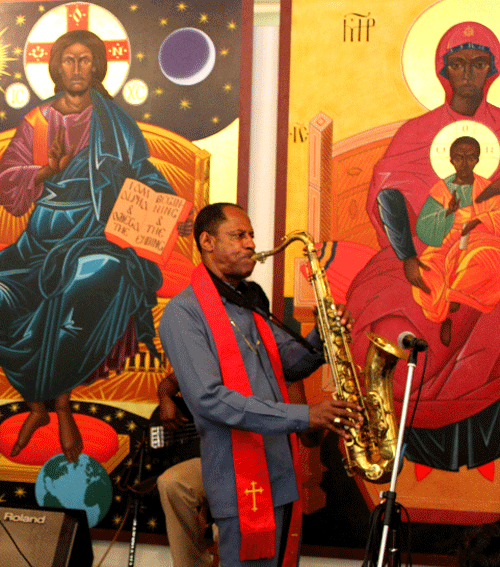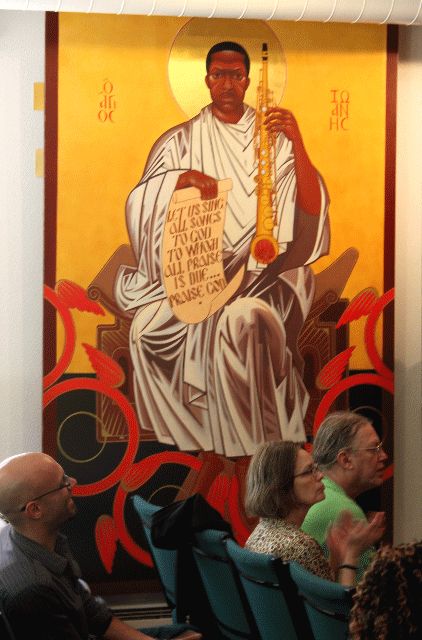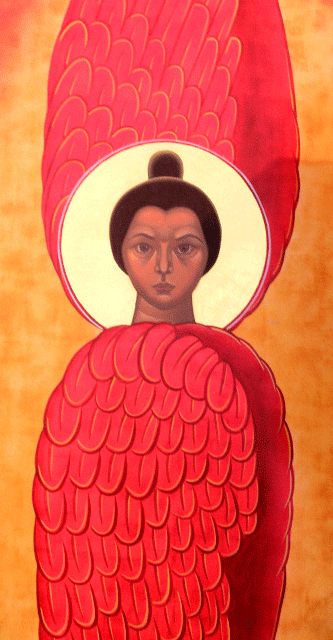By James DeKoven
Without hestitation, the Rev. Wanika King-Stephens can name her favorite John Coltrane song: “What’s New?” Then, true to form for any music obsessive, she provides additional knowledge: The song was originally on the album Ballads, released by the Impulse! label.
Jazz records and churches are not usually an easy fit. But this church, at 1286 Fillmore Street, is no ordinary house of worship. It’s the Saint John Will-I-Am Coltrane African Orthodox Church, or as it’s known to people around the world, the Church of John Coltrane.
Every Sunday from noon to 3 p.m., Rev. King-Stephens sits in with other members of the house band — the “Ministers of Sound” — and they perform the music of John Coltrane as a vehicle to praise God. They call it “sound praise.”
Looking at the exterior of the church, passersby might assume they’re seeing the entrance to a business or an office for the community center upstairs. Only upon stepping inside does it become clear it is in fact a holy place.
Adorning the walls are murals of Jesus, Madonna with child and John Coltrane wearing religious vestments. The smell of sweet incense fills the air. Approximately 50 chairs snugly fit into a small room. On a recent Sunday, the congregation is a mix of church members, ’Trane devotees, curious tourists and locals just wondering what it’s all about.
The band sets up at the front of the room, without a stage, and with no formal introductions immediately goes into “Lonnie’s Lament.” There’s the reverend herself on bass, Frederick Harris on electric piano, Roberto De Haven on tenor sax and Max Hoff on drums. In the far left corner, behind Hoff, is Arthur Trotter at the congas, wearing a Che Guevara T-shirt. The church founder, Archbishop Franzo King, who usually takes the tenor sax seat, couldn’t make it that day.The performance is part of a traditional Christian liturgy, comprised of prayers and confessionals that are sung to some of the jazz great’s more devotional songs, including beautiful interpretations of “Spiritual,” “Acknowledgement” and, fittingly, “A Love Supreme.” Two hours of music is followed by an hour-long sermon.
A communal vibe and a joyous energy permeate the room. A few parishioners play tambourines against a palm or thigh. Some shout “hallelujah.” Others do call and response with choir. Faces smile, heads nod, bodies move.
As Harris plays a cascading piano solo over the plodding hum of bass and drums, Toes Tiranoff and Megan Haungs — unofficial members of the band — take turns tap dancing on a tabletop placed on the floor.
The Ministers of Sound is not a tribute band playing note-for-note renditions. Nor is it a group of amateurs just giving it a go. These are expert musicians, spiritually dedicated to the author of the compositions, playing music not of this earth for reasons that float in the heavens.Even before his death in 1967, ’Trane was awarded divine status by jazz aficionados. Many found his performances unworldly.
Albert Ayler, his lesser known but equally innovative contemporary, once said: “’Trane was the Father, Pharoah (Sanders) was the Son, I was the Holy Ghost.” Then, Coltrane ascended from figurative to literal saint when Franzo King founded the church in 1971, and after it became associated with the African Orthodox Church, he was officially canonized.
“A saint is simply someone who lives a sanctified life,” is Reverend King-Stephens’ retort to anyone challenging Coltrane’s qualifications, given that he died a mere 42 years ago and wasn’t responsible for any miracle. “He wanted to make music that would make people happy,” she says.
Filed under: Music








